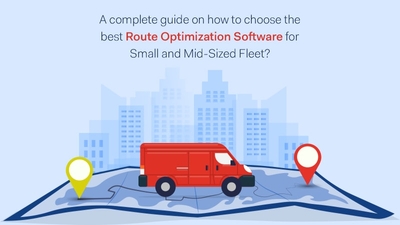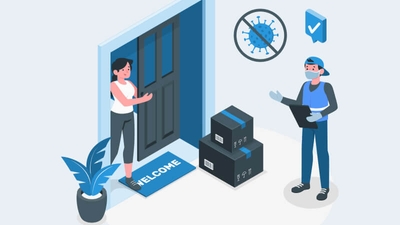The courier and delivery business is opening up new avenues for the eCommerce markets by simplifying the way how products are delivered. Indeed, it is a lucrative business these days when it comes to handling the logistics of eCommerce startups.

Due to globalisation, the businesses are spreading rapidly and the courier industry is expanding at its best. The demand for faster, efficient and trackable delivery is soaring and competition is severe when it comes to last-mile delivery. Such situations pose a few amounts of challenges to the courier industry.
Especially to the ones who are entering the marketing and even to those who are experiencing a transit from conventional services to the modern one.
The biggest question is how they can play shoulder to shoulder with the big giants leveraging technology and brand identity.
Here are a few challenges that the courier businesses are facing along with the available solutions to deal with those.
Challenge 1: Highly Competitive Industry
There are no thoughts on who Royal Mail, DHL, FedEx and few others dominate the courier service market globally.
These are the global players with wide networks riding on the strong pine of technology to benefit from.
Competing with these giants is a David vs Goliath battle. Beheading these giants is no easy since the trust, capital and technology favours the formers. So, how can a small company compete with these giants?

Solution: Finding a niche
The key lies in providing specialized services to customers that are down to earth and more personal. This is one way of expanding the potential for carving ones niche for market penetration.
Attempting to be the giant is not the right way to proper, instead, the aim should be to be unique and try differentiating the services from the rest of the competitors. Offering new features for tracking the order, custom packaging and blending in other innovations grab customer attention.
Achieving such standards will need them to incorporate the latest courier delivery solutions. Another way to start with a buzz is to have to execute operations in place which would rather turn these challenges into advantages.
Challenge 2: Market Demands
Another challenge for the courier company involves reading the market data to better understand the demands. Going gung-ho without the active knowledge may leave even live tracking for delivery falling flat.
With market dynamics changing drastically, staying up-to-date with the data requires extra efforts to deliver exactly what customers are looking for. The solution to Challenge 1 may also pose a challenge with regards to analysing the market scenarios and customer demands.
Solution: Understanding customers, better
Understanding customers is easier said than done. While the courier delivery system may execute things technically from the back-end, the customer demands are better understood by conducting first-hand research. Most common of all their demands are:
Being on their side
Courier companies need to understand that customers want them to be on their side – as their representatives within the purview of sellers’ organisation.
Being accountable (personally) for the desired results
The courier companies equipped with courier delivery tracking software will have to take responsibility. Turning the complaining customers away is the biggest turn-off and you’d not want such a market perspective. Courier businesses need to own the accountability of products while also assuring a smooth and relationship between both the parties involved.
Being Proactive
Proactive-ness is a way to stay ahead of what customers expect. Understanding customers is understanding the market and this is why each customer is important. Try anticipating problems from the customers’ end and solve them in advance ahead of the time.
Available to solve problems
Usually, courier companies call it a ‘job done’ when the package is delivered to the customer. Anything after that is supposed to be dealt with by the other two parties. Try getting in between both the parties and ask out if the package received is as expected. Offer assistance if not.
Responding to their needs
As mentioned in the above point, responding to customer’s need is essential to survive in the business. The needs may be out loud or just mentioned – picking up the cues is crucial.
Challenge 3: Increased Staffing Needs
Few courier companies rely heavily on the stringent manual process which may result in inflated staff with a lot of loopholes.
Regardless of the training and attempts to standardise the process, the nature of business will always lead to some or the other manual snag.
This may even result in employees occupied with a plethora of unexpected workload. On the other hand, there will be times where few of the other people are idle and others may be engaged way too much. Balancing the team becomes crucial or else the staffing need keeps shooting up.
And even during the festive season and special discount sales, the deliveries are higher than expected. It gets busy, messy and haywire to manage each order with utmost discipline.
Such time demands to hire additional staff to cater to huge market demands. And this means additional cost to the courier business. Here’s an effective solution.

Solution: Automating the processes
Courier companies then have to balance the additional staffing costs and their profits. Hiring staff optimally is one thing but then nothing beats the call to automize the entire process. One way to tackle this is by getting route optimization software for the courier deliveries.
This not only pleases the customers and sellers with fast delivery timings but also shrinks the costs associated with hiring. And even for the non-commercial deliveries opting on-demand courier delivery app development is a great workaround to mitigate the operational risks involved in manual logistic management for the deliveries.
Introducing the mobile technology in courier business also ensures that the shipment interacts with the system at every step – right from warehouse movement to last-mile delivery.
Challenge 4: Keeping Customers Updated
Courier business is getting dynamic with time. Customers like to stay updated with the whereabouts of their packages from time to time. And since they are now well-informed the question of loyalty doesn’t arise.
Picking the one courier service who keeps them informed is one of the top priorities. That is why succeeding in a highly competitive market will require courier companies to stay connected with their customers. Failing to do so may result in losing customers to competitors, especially the ones who use real-time last-mile delivery software.
One of the reasons why this challenge exists is often due to the nature of the business that the courier companies across the globe deal with. There looms an uncertainty regarding whether or not the parcel is delivered.
The conventional delivery businesses keep the manual records of the receipt of the package which may reflect poor delivery coordination and collection mismatches. Also, apart from wasting the manual labour time, it leaves a weak audit trail for the deliveries.
Solution: Building a Seamless Communication System
To ensure smooth communication in the courier business, having the best courier delivery solutions is important. Courier companies not informing them about their packages is unforgiving from the sender’s perspective. And this why real-time last-mile delivery tracking software is quintessential for succeeding in the industry.
The key is to provide customers with all the required information, updated along with the forecast on where and when the package will be delivered. Technology plays an integral role in the fast-evolving courier industry and efficiently meeting customer demands.
Senders of parcels need to be notified of the status of their parcels. Recipients also should be notified when their parcels are due for delivery too. Lack of delivery notifications creates uncertainty among clients regarding your services.
They are likely to seek services from other companies they can trust. And adopting such courier delivery tracking software will enable courier businesses to send the package notifications automatically.
Conclusion
Highly advanced courier businesses succeed only if they can match the pace with time. Though eCommerce traders are looking for cheap delivery options, implementing the latest courier delivery systems will add a unique status to your business.
Most of the vendors charge a premium for the trackable delivery and customers are willing to pay a bit extra for that. This expenses can be covered by charging customers a premium rate for the faster delivery with other additional services like package guarantee, tracking and post-delivery pickup if required for sending the package again.




